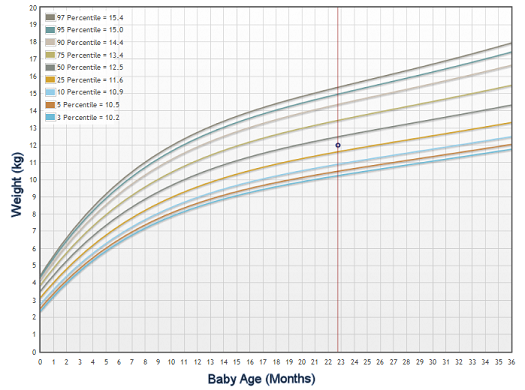Disk Capacity planning (A short story)

One very important (but more-often-than-not forgotten) aspect of building and deploying any new system is capacity planning.
Capacity planning?
Yes.
Only the most trivial of systems can “just go live” without a second thought (and even for these one would argue against). For everyone else, not planning ahead is the same as wishing that noone ever uses your system.
A few hours spent a priori doing a paper or Excel exercise can save orders of magnitude more hours trying to fix things a posteriori.
A good way to consider capacity planning is like a baby growth chart. If you have not seen one, it looks something like this

In other words, based on some “realistic guesstimations” (see what I did there?) you are projecting a low- and high-watermark for the future.
This exercise will allow you to do 2 things:
- plan your resource expenditure if things go as (or worse-than, or better-than) expected
- and, most importantly, force you to actually sit down and study the intricate details and implications of your technology choices
Even if you are in a situation like “Yeah, ok! I am only working on this little project on the side. How big can it be?”.
Allow me to tell you a little story. It was a big lesson for me, it may help you as well.
Once upon a time…
The year is 2006-2007 and a friend’s friend needs my help. He has a small business which monitors the performance of large refrigeration systems. He installs a small internet-connected sensor, this gathers some metrics every 3’ or so, uploads at night to an FTP server as a small CSV. My friend then copies the files manually and does some (simple) processing to calculate some aggregates, convert from 3’ to 15’. This is the time-consuming bit that he wants to automate. Oh, yes! and keep old 3’ and 15’ measurements somewhere in order to re-visit them in the future (e.g. for simulation).
A nice repetition of keywords in the requirements: small, small, simple.
Yeap, that’s what I thought

So let’s see some basic figures
- Each sensor generates a CSV file 24Kb in size, sent nightly over FTP (1)
- …containing 480 individual measurements/rows (2)
- He currently had 10 clients (3)
- …each one with 120 sensors per site (4)
Which gave us a mere 576000 rows per day and ~28 Mb to be processed. Ok, nothing unmanageable! A run-of-the-mill system with JDBC/MySQL/Hibernate would be more than enough, right? I was already considering how he could perhaps start small with some computers installed on-premise to keep costs down.
Let’s expand on the above, though. I asked him for his optimistic growth plans/targets 1, 2, 3 years out. (Optimistic for business is almost always pessimistic for IT ;-))
So, he aimed to have 100 new clients per year.
Hmm, how did this all add up? Excel is our friend here.
3 years on, the system would have to be accepting, processing in a couple of hours and storing perpetually 17 million new rows per day and 864 Mb of new data. The database would need to store over 2 billion additional rows per year with an additional disk footprint of 300 Gb

Remember, this is 2007. BigData is an unknown term, Hadoop has only just span out of Nutch (so not even alpha), storage and hosting is friggin’ expensive (Amazon web services were at their infancy still).
…and they lived happily ever after
It may sound silly now, but that was really an eye-opening moment.
Unfortunately, the project did not go past the proof-of-concept stage, but that was a really important lesson for me.
Never, EVER, forget to do some pessimistic capacity planning
